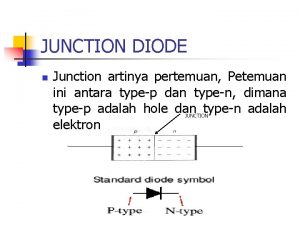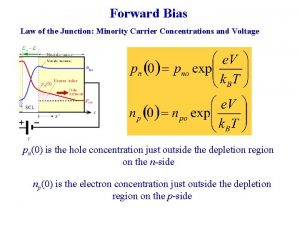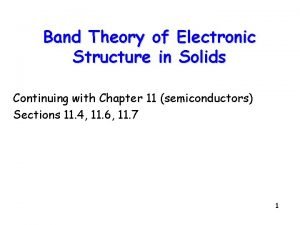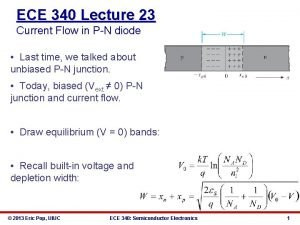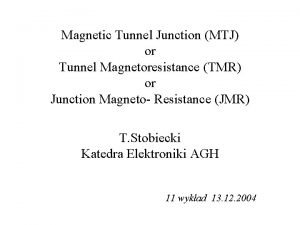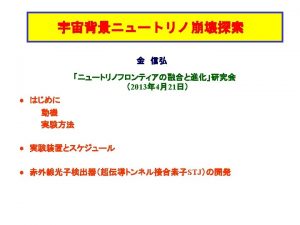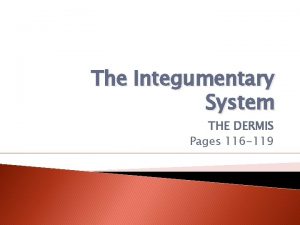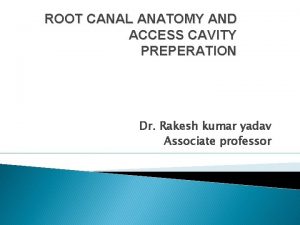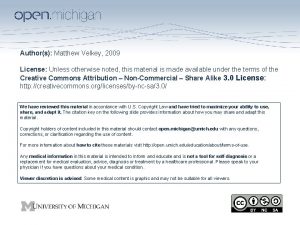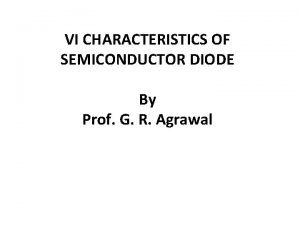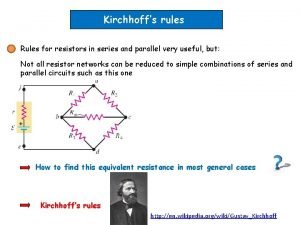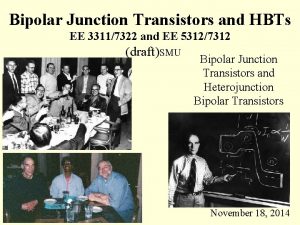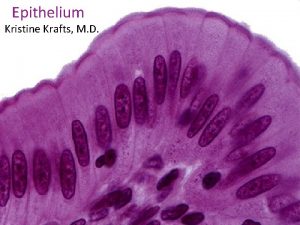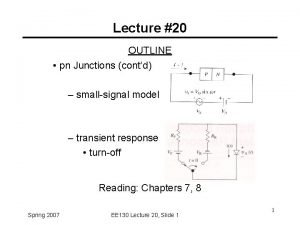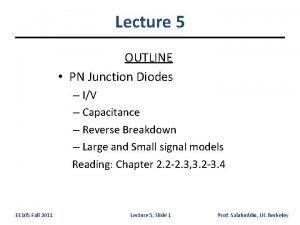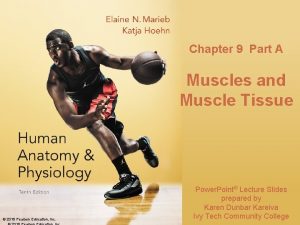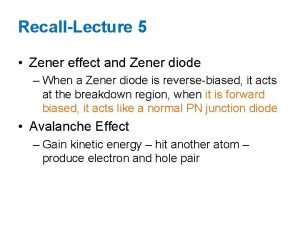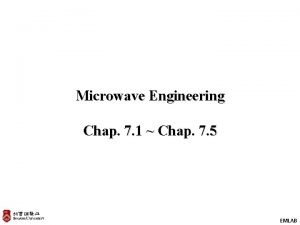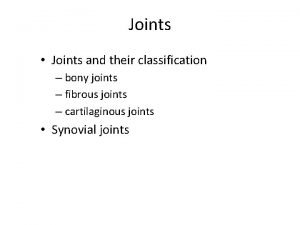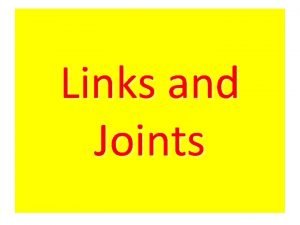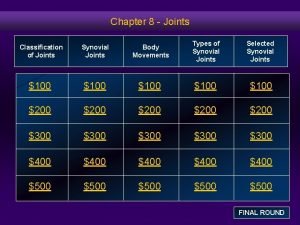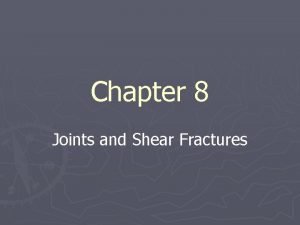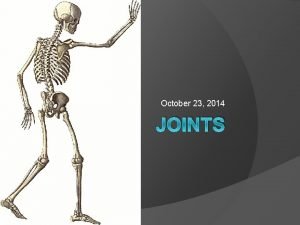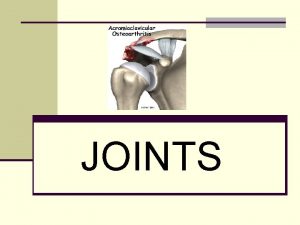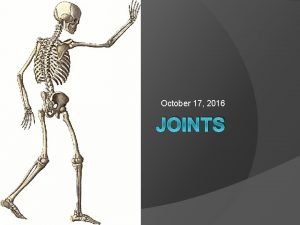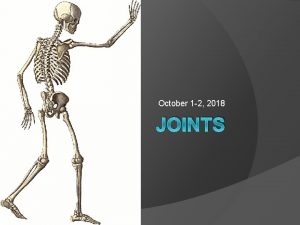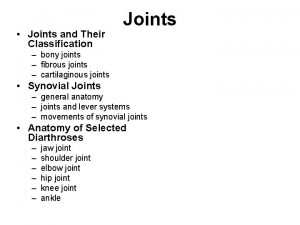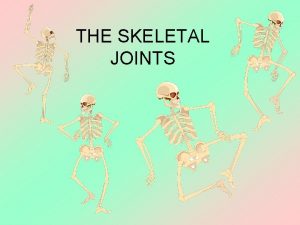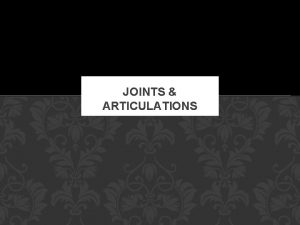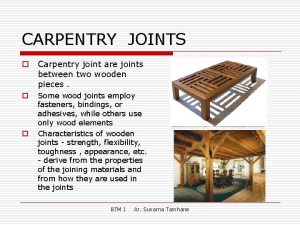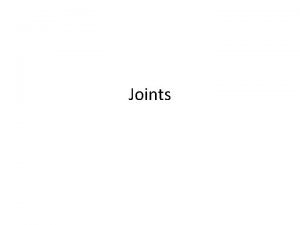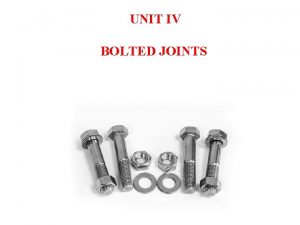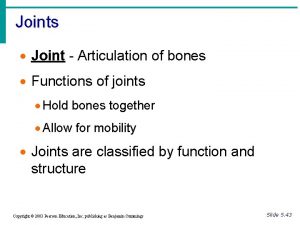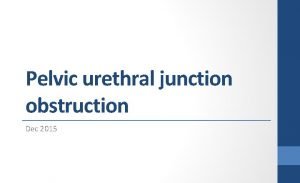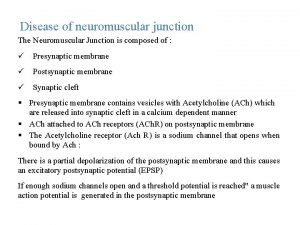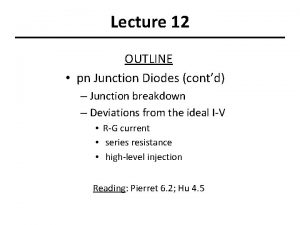JOINTS JOINT A joint is the junction or








































































- Slides: 72

JOINTS

JOINT A joint is the junction or pivot point between two or more bones. Movement of the body as a whole results from the rotation of bones about individual joints. Joints transfer and dissipate forces produced by gravity and muscle activation. Dr. Michael P. Gillespie 2

ARTHROLOGY Arthrology is the study of the classification, structure, and function of joints. Aging, long-term immobilization, trauma, and disease all affect the structure and ultimate function of joints. These factors influence the quality and quantity of human movement. Dr. Michael P. Gillespie 3

CLASSIFICATION OF JOINTS Structural Classification Presence Dr. Michael P. Gillespie or absence of a space (synovial cavity) Type of Connective Tissue Functional Classification Relates to the degree of movement they permit. 4

CLASSIFICATION OF JOINTS BASED ON MOVEMENT POTENTIAL Two major types of joints exist within the body: Synarthroses Dr. Michael P. Gillespie Diarthroses 5

JOINTS OF THE BODY Dr. Michael P. Gillespie 6

SYNARTHROSES A synarthrosis is a junction between two bones that allows slight to essentially no movement. Synarthroidial joints can be classified as either fibrous or cartilaginous based upon the dominant type of connective tissue. Dr. Michael P. Gillespie 7

TYPES OF SYNARTHROSES Fibrous joints Dense Dr. Michael P. Gillespie connective tissue (high concentration of collagen) Sutures of the skull Joints reinforced by an interosseous membrane (distal tibiofibular joint). Cartilaginous joints Flexible cartilage or hyaline cartilage Symphysis pubis Interbody joints of the spine Manubriosternal joint 8

DIARTHROSES (SYNOVIAL JOINTS) A diarthrosis is an articulation that allows moderate to extensive motion. Possess a synovial fluid-filled cavity. Compose the majority of the joints within the musculoskeletal system. Dr. Michael P. Gillespie 9

SEVEN ELEMENTS OF DIARTHRODIAL JOINTS Articular cartilage – covers the ends and other articular surfaces of bones Joint capsule (articular capsule) – peripheral curtain of connective tissue Synovial membrane – dcxf vcdx d cxdfv cxfefdsex Synovial fluid Ligaments Dr. Michael P. Gillespie Capsular ligaments Extracapsular ligaments Blood vessels Sensory nerves 10

ELEMENTS OF SYNOVIAL JOINTS Dr. Michael P. Gillespie 11

INTRA-ARTICULAR DISCS (MENISCI) Intra-articular discs (meninsci) – pads of fibrocartilage imposed between articular surfaces. These pads increase congruency and improve force dispersion. Examples of intra-articular discs (knee) Distal radio-ulnar Sternoclavicular Acromioclavicular Temporomandibular Apophyseal (variable) Dr. Michael P. Gillespie Tibiofemoral 12

PERIPHERAL LABRUM A peripheral labrum of fibrocartilage extends from the body rims of the glenoid fossa to the shoulder and the acetabulum of the hip. These structures deepen the concave surface of the joint. These structures support and thicken the attachment of the joint capsule. Dr. Michael P. Gillespie 13

FAT PADS Fat pads thicken the joint capsule, causing the inner surface of the capsule to fill nonarticulating joint spaces formed by incongruent bony contours. They are prominent in the elbow and knee joints. Enlarged and inflamed fat pads can adversely affect the biomechanics of the joint. Dr. Michael P. Gillespie 14

BURSAE A bursa is an extension or outpouching of the synovial membrane of a diarthroidial joint. Bursae are filled with synovial fluid and exists in areas of potential stress. Bursae help to absorb force and protect periarticular connective tissues, including bone. Dr. Michael P. Gillespie 15

SYNOVIAL PLICA Synovial plicae (synovial folds, synovial redundancies, or synovial fringes) are slack, overlapped pleats of tissue composed of the innermost layers of the joint capsule. They are found in joints with large capsular surface area such as the knee and elbow. They increase the synovial surface area and allow full joint motion without undue tension on the synovial lining. Folds that are thickened or adhered due to inflammation can alter the joint biomechanics. Dr. Michael P. Gillespie 16

STRUCTURAL CLASSIFICATION OF JOINTS Fibrous Joints CT Lack a synovial cavity Cartilaginous Joints Cartilage Lack a synovial cavity Synovial Dr. Michael P. Gillespie Fibrous Joints Have a synovial cavity Dense irregular CT Often associated with accessory ligaments 17

FUNCTIONAL CLASSIFICATION OF JOINTS Synarthrosis (syn = together) Immovable Amphiarthrosis (amphi = on both sides) A slightly moveable joint Diarthrosis (moveable joint) A freely moveable joint Synovial joints Dr. Michael P. Gillespie joint 18

FIBROUS JOINTS Lacks a synovial cavity Little or no movement Dr. Michael P. Gillespie 19

FIBROUS JOINTS Sutures Synostosis the adult – suture that is replaced by bone in Syndesmoses Slightly moveable (amphiarthrosis) Ligament Interosseous membrane Dr. Michael P. Gillespie Immovable Gomphoses Dentoalveolar joint 20

CARTILAGINOUS JOINTS Lacks a synovial cavity Allows little or no movement Synchondroses plate Symphyses Pubic symphisis Intervertebral discs Dr. Michael P. Gillespie Epiphyseal 21

SYNOVIAL JOINTS Synovial (Joint) Cavity – space btwn. Bones Freely moveable The bones are covered by hyaline cartilage Contains the following: capsule Synovial fluid Accsessory ligaments and articular discs Dr. Michael P. Gillespie Articular 22

CLASSIFICATION OF SYNOVIAL JOINTS BASED ON MECHANICAL ANALOGY Hinge joint Pivot joint Ellipsoid joint Ball-and-socket joint Plane joint Saddle joint Condyloid joint Dr. Michael P. Gillespie 23

HINGE JOINT Primary Angular Motions Flexion Mechanical Analogy Door hinge Anatomic Examples Humero-ulnar joint Interphalangeal joint Dr. Michael P. Gillespie and extension only 24

HINGE JOINT Dr. Michael P. Gillespie 25

PIVOT JOINT Primary Angular Motions Spinning Mechanical Analogy Doorknob Anatomic Examples Humeroradial joint Atlanto-axial joint Dr. Michael P. Gillespie of one member around a single axis of rotation 26

PIVOT JOINT Dr. Michael P. Gillespie 27

ELLIPSOID JOINT Primary Angular Motions Biplanar Mechanical Analogy Flattened convex ellipsoid paired with a concave trough Anatomic Examples Radiocarpal Dr. Michael P. Gillespie motion (flexion-extension and abductionadduction) joint 28

ELLIPSOID JOINT Dr. Michael P. Gillespie 29

BALL-AND-SOCKET JOINT Primary Angular Motions Triplanar Mechanical Analogy Spheric convex surface paired with a concave cup Anatomic Examples Dr. Michael P. Gillespie motion (flexion-extension, abductionadduction, and internal-external rotation) Glenohumeral joint Coxofemoral (hip) joint 30

BALL-AND-SOCKET JOINT Dr. Michael P. Gillespie 31

PLANE JOINT Primary Angular Motions Slide Mechanical Analogy Relatively flat surfaces apposing each other, like a book on a table Anatomic Examples Carpometacarpal Dr. Michael P. Gillespie (translation) or combined slide and rotation joints (digits II to IV) Intercarpal joints Intertarsal joints 32

PLANE JOINT Dr. Michael P. Gillespie 33

SADDLE JOINT Primary Angular Motions Biplanar Mechanical Analogy Each member has a reciprocally curved concave and convex surface oriented at right angles to the other, like a horse rider and a saddle Dr. Michael P. Gillespie motion Spin between bones is possible, but may be limited by interlocking nature of joint Anatomic Examples Carpometarcarpal joint of the thumb Sternoclavicular joint 34

SADDLE JOINT Dr. Michael P. Gillespie 35

CONDYLOID JOINT Primary Angular Motions Biplanar Mechanical Analogy Mostly spheric convex surface that is enlarged in one dimension like a knuckle; paired with a shallow concave cup Dr. Michael P. Gillespie motion Either flexion-extension and abduction-adduction, or flexion-extension and axial rotation (internal-external rotation) Anatomic Examples Metacarpophalangeal joint Tibiofemoral (knee) joint 36

CONDYLOID JOINT Dr. Michael P. Gillespie 37

SIMPLIFYING THE CLASSIFICATION OF SYNOVIAL JOINTS Two articular forms based upon true movement of the joint Saddle joint Essentially all synovial joints of the body with the notable exception of planar joints can be categorized under this scheme. Dr. Michael P. Gillespie Ovoid 38

OVOID JOINT An ovoid joint has paired mating surfaces that are imperfectly spheric, or egg-shaped, with adjacent parts possessing a changing surface curvature. The articular surface of one bone is convex and of the other is concave. Most joints of the body are of this variety. Dr. Michael P. Gillespie 39

SADDLE JOINT A saddle joint consists of paired convex and concave surfaces oriented at approximately 90 degrees to each other. Each member has a reciprocally curved concave and convex surface oriented at right angles to the other, like a horse rider and a saddle. Dr. Michael P. Gillespie 40

BASIC SHAPES OF JOINT SURFACES Dr. Michael P. Gillespie 41

Dr. Michael P. Gillespie 42

BIOLOGICAL MATERIALS OF PERIARTICULAR CONNECTIVE TISSUES Fibrous Proteins Collagen Ground Substance Glycosaminoglycans Water Solutes Dr. Michael P. Gillespie (type I and II) Cells Fibroblasts Chondrocytes 43

TYPES OF COLLAGEN IN PERIARTICULAR CONNECTIVE TISSUES Type I Thick, Type II Thinner fibers than type I Provide a framework for maintaining the general shape and consistency of structures, such as hyaline cartilage Dr. Michael P. Gillespie rugged fibers that elongate when stretched Present in ligaments, tendons, fascia, and fibrous joint capsules 44

TYPES OF MOVEMENTS AT SYNOVIAL JOINTS Gliding back and forth movement, limited in range, planar joints Angular Movements Increase or decrease in the angle btwn. bones Rotation Bone Dr. Michael P. Gillespie Simple revolves around a longitudinal axis Special Movements 45

ANGULAR MOVEMENTS Flexion, extension, lateral flexion, hyperextension Abduction, adduction, and circumduction Dr. Michael P. Gillespie 46

ROTATION Medial (internal) rotation Lateral (external) rotation Dr. Michael P. Gillespie 47

SPECIAL MOVEMENTS Elevation Depression Protraction Retraction Inversion Dr. Michael P. Gillespie 48

SPECIAL MOVEMENTS Eversion Dorsiflexion Plantar flexion Supination Pronation Opposition Dr. Michael P. Gillespie 49

DISLOCATION Luxation – displacement of a bone from a joint Causes Subluxation Incomplete dislocation Dr. Michael P. Gillespie tearing or ligaments, tendons, and articular capsules 50

ARTHROSCOPY Observaion of the interior of a joint Utilizes a lighted, pencil-thin instrument Assists in surgery and assessment of the joint space Dr. Michael P. Gillespie 51

SPRAIN & STRAIN The ankle joint is the most often sprained. The lumbar spine is another prominent location of sprain. Strain – a stretched or partially torn muscle. Dr. Michael P. Gillespie Sprain – a forcible wrenching or twisting of the joint that stretches or tears its ligaments, but does not dislocate the bones. 52

BURSAE & TENDON SHEATHS Bursae Saclike Tendon sheaths Tubelike bursae that wrap around tendons Occurs where tendons pass through synovial cavities Reduce friction Dr. Michael P. Gillespie structures Reduce friction in some synovial joints 53

BURSITIS An Pain, swelling, inflammation & limited movement Dr. Michael P. Gillespie acute or chronic inflammation of a bursa Caused by trauma or infection Repeated excessive exertion Symptoms Treatment Oral anti-inflammatory agents (herbal, O. T. C. And prescription), corticosteroid injections 54

Dr. Michael P. Gillespie 55

Dr. Michael P. Gillespie 56

Dr. Michael P. Gillespie 57

Dr. Michael P. Gillespie 58

Dr. Michael P. Gillespie 59

Dr. Michael P. Gillespie 60

ROTATOR CUFF INJURY Supraspinatous Infraspinatous Teres Minor Subscapularis Common injury among pitchers and volleyball players due to excessive circumduction Dr. Michael P. Gillespie 61

SEPARATED SHOULDER Injury of the acromioclavicular joint Due to forceful trauma such as when the shoulder strikes the ground in a fall Dr. Michael P. Gillespie 62

TENNIS ELBOW Lateral epicondylitis Little-league elbow Dr. Michael P. Gillespie 63

GOLFER’S ELBOW Medial Epicondylitis Dr. Michael P. Gillespie 64

DISLOCATION OF THE RADIAL HEAD The most common upper limb dislocation in children Occurs with a strong pull to the forearm while it is extended and supinated Swinging a child around with outstretched arms Dr. Michael P. Gillespie 65

SWOLLEN KNEE Immediate swelling is due to blood loss Delayed swelling is due to excessive production of synovial fluid “water on the knee” Dr. Michael P. Gillespie 66

DISLOCATED KNEE Displacement of the tibia relative to the femur Most commonly dislocates anteriorly Dr. Michael P. Gillespie 67

RHEUMATISM Dr. Michael P. Gillespie Any painful disorder of the supporting structures of the body – bones, ligaments, tendons, or muscles – that is not caused by infection or injury. 68

ARTHRITIS A form of rheumatism in which the joints are swollen, stiff, and painful. Dr. Michael P. Gillespie 69

TYPES OF ARTHRITIS Rheumatoid arthritis (RA) Autoimmune Osteoarthritis (OA) Degenerative joint disease Gouty arthritis A person with gout produces excessive uric acid or is unable to excrete it properly Dr. Michael P. Gillespie disease – the body attacks its own tissues 70

LYME DISEASE First reported in Lyme, CT Bacteria transported by deer ticks The rash often resembles a bull’s eye target, although some people never develop a rash Symptoms stiffness, fever, chills, headache, stiff neck, nausea Dr. Michael P. Gillespie Joint 71

TERMINOLOGY Arthralgia – pain in a joint Bursectomy – removal of a bursa Chondritis – inflammation of cartilage Synovitis – inflammation of a synovial membrane in a joint Dr. Michael P. Gillespie 72
 Conjunction junction what's your function
Conjunction junction what's your function 101012 bằng
101012 bằng Vẽ hình chiếu vuông góc của vật thể sau
Vẽ hình chiếu vuông góc của vật thể sau ưu thế lai là gì
ưu thế lai là gì Alleluia hat len nguoi oi
Alleluia hat len nguoi oi Một số thể thơ truyền thống
Một số thể thơ truyền thống Tư thế ngồi viết
Tư thế ngồi viết Từ ngữ thể hiện lòng nhân hậu
Từ ngữ thể hiện lòng nhân hậu Cong thức tính động năng
Cong thức tính động năng đặc điểm cơ thể của người tối cổ
đặc điểm cơ thể của người tối cổ Tư thế ngồi viết
Tư thế ngồi viết Tỉ lệ cơ thể trẻ em
Tỉ lệ cơ thể trẻ em Các châu lục và đại dương trên thế giới
Các châu lục và đại dương trên thế giới Thẻ vin
Thẻ vin Hổ sinh sản vào mùa nào
Hổ sinh sản vào mùa nào Kể tên các môn thể thao
Kể tên các môn thể thao Hình ảnh bộ gõ cơ thể búng tay
Hình ảnh bộ gõ cơ thể búng tay Bàn tay mà dây bẩn
Bàn tay mà dây bẩn Diễn thế sinh thái là
Diễn thế sinh thái là Thế nào là mạng điện lắp đặt kiểu nổi
Thế nào là mạng điện lắp đặt kiểu nổi Trời xanh đây là của chúng ta thể thơ
Trời xanh đây là của chúng ta thể thơ V. c c
V. c c Lời thề hippocrates
Lời thề hippocrates Gấu đi như thế nào
Gấu đi như thế nào Thể thơ truyền thống
Thể thơ truyền thống Thế nào là hệ số cao nhất
Thế nào là hệ số cao nhất đại từ thay thế
đại từ thay thế Sự nuôi và dạy con của hươu
Sự nuôi và dạy con của hươu Dạng đột biến một nhiễm là
Dạng đột biến một nhiễm là Lp html
Lp html Vẽ hình chiếu vuông góc của vật thể sau
Vẽ hình chiếu vuông góc của vật thể sau Mật thư tọa độ 5x5
Mật thư tọa độ 5x5 Vẽ hình chiếu đứng bằng cạnh của vật thể
Vẽ hình chiếu đứng bằng cạnh của vật thể Thiếu nhi thế giới liên hoan
Thiếu nhi thế giới liên hoan Glasgow thang điểm
Glasgow thang điểm Quá trình desamine hóa có thể tạo ra
Quá trình desamine hóa có thể tạo ra Hệ hô hấp
Hệ hô hấp Các châu lục và đại dương trên thế giới
Các châu lục và đại dương trên thế giới điện thế nghỉ
điện thế nghỉ Thế nào là sự mỏi cơ
Thế nào là sự mỏi cơ Bảng số nguyên tố
Bảng số nguyên tố Bổ thể
Bổ thể Phản ứng thế ankan
Phản ứng thế ankan Break joint vs spool joint
Break joint vs spool joint Ligamentum nuchae
Ligamentum nuchae Plane joints
Plane joints Example of semi permanent joint is
Example of semi permanent joint is Cutability
Cutability Appretaite
Appretaite Biasn
Biasn Energy band diagram of pn junction
Energy band diagram of pn junction Electronic structure of solid band theory
Electronic structure of solid band theory Qualitative description of current flow at a junction
Qualitative description of current flow at a junction Mtj junction
Mtj junction Superconducting tunnel junction
Superconducting tunnel junction Papillary dermal layer
Papillary dermal layer Flowchart summing junction
Flowchart summing junction Cementodentinal junction
Cementodentinal junction Parietal cell histology
Parietal cell histology Characteristics of a semiconductor diode
Characteristics of a semiconductor diode Bipolar junction transistor lecture notes
Bipolar junction transistor lecture notes The junction rule
The junction rule Ee clapham junction
Ee clapham junction Kristine krafts
Kristine krafts Small signal model of pn junction diode
Small signal model of pn junction diode Ductus thoracicus
Ductus thoracicus Diode application
Diode application T tubule
T tubule Tyco junction box
Tyco junction box Vo
Vo T junction power divider
T junction power divider Subepidermal bulla
Subepidermal bulla T junction flemish bond
T junction flemish bond

















































